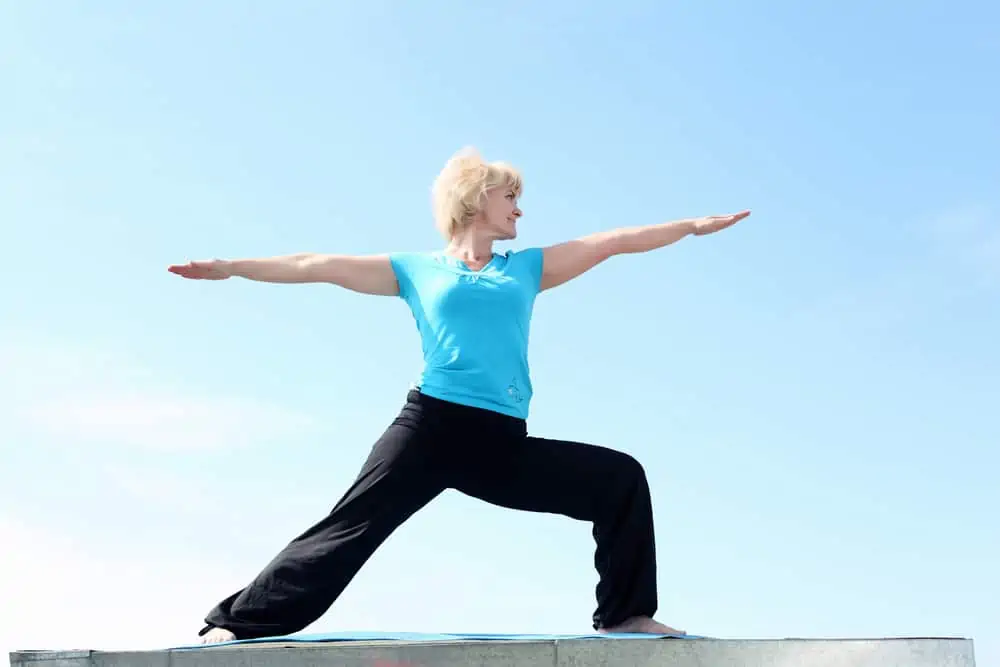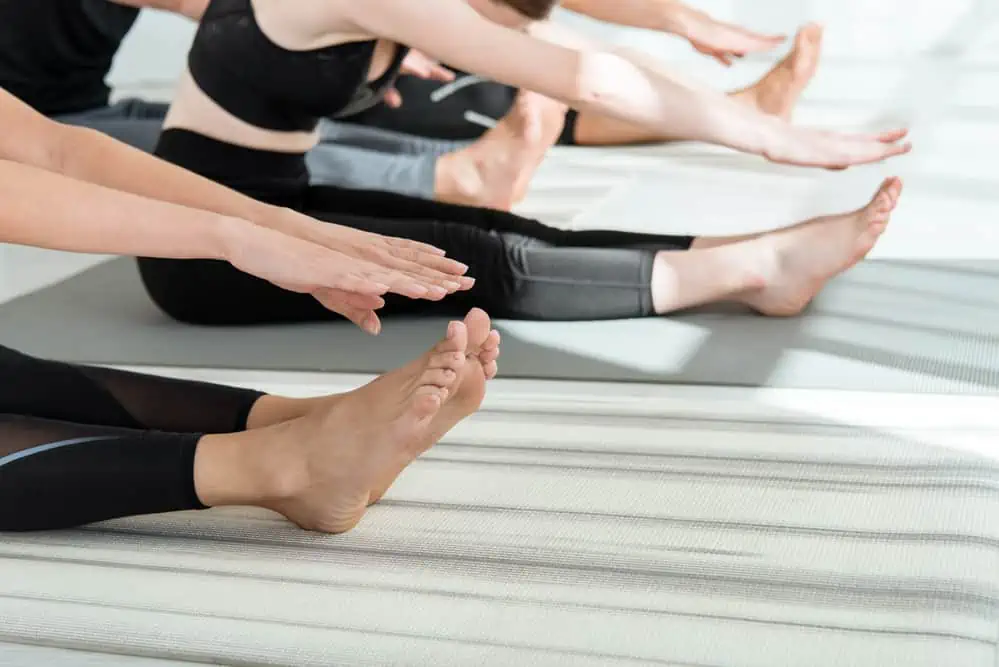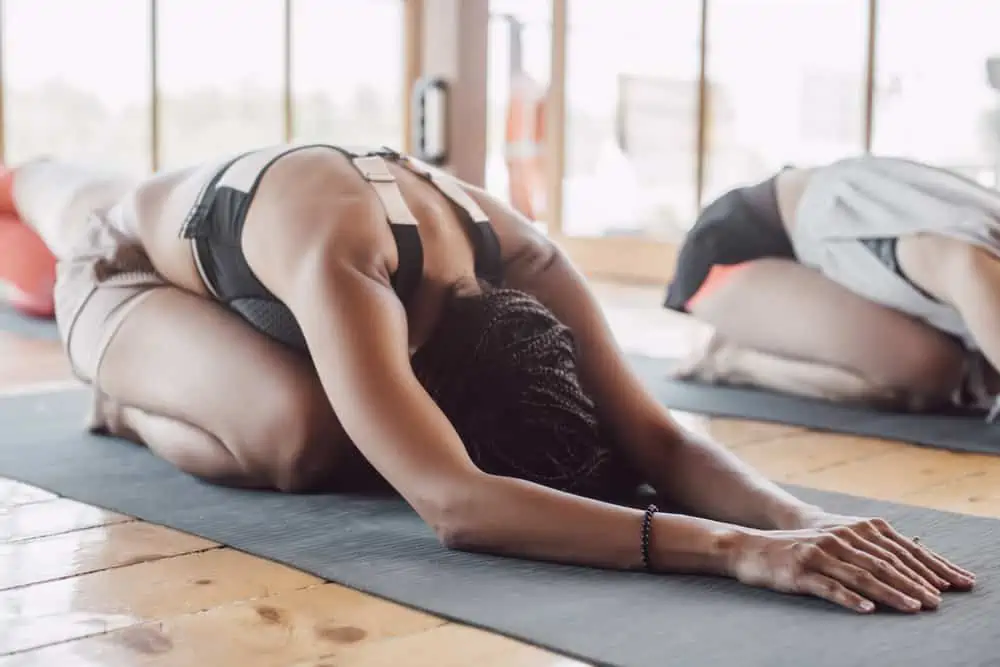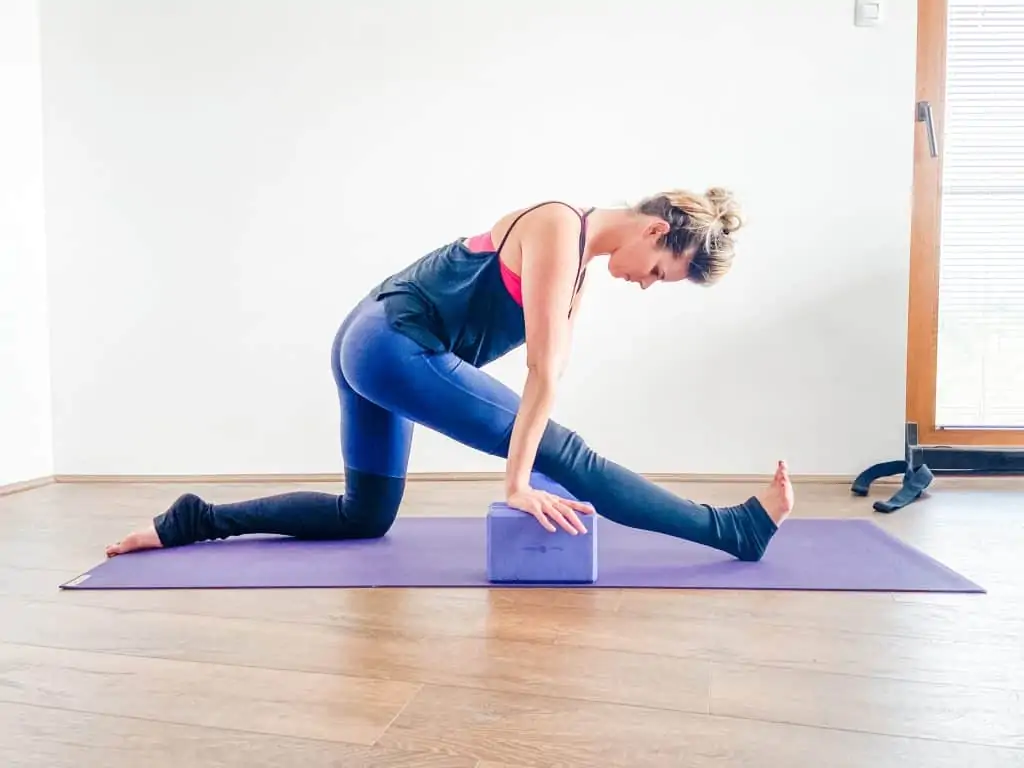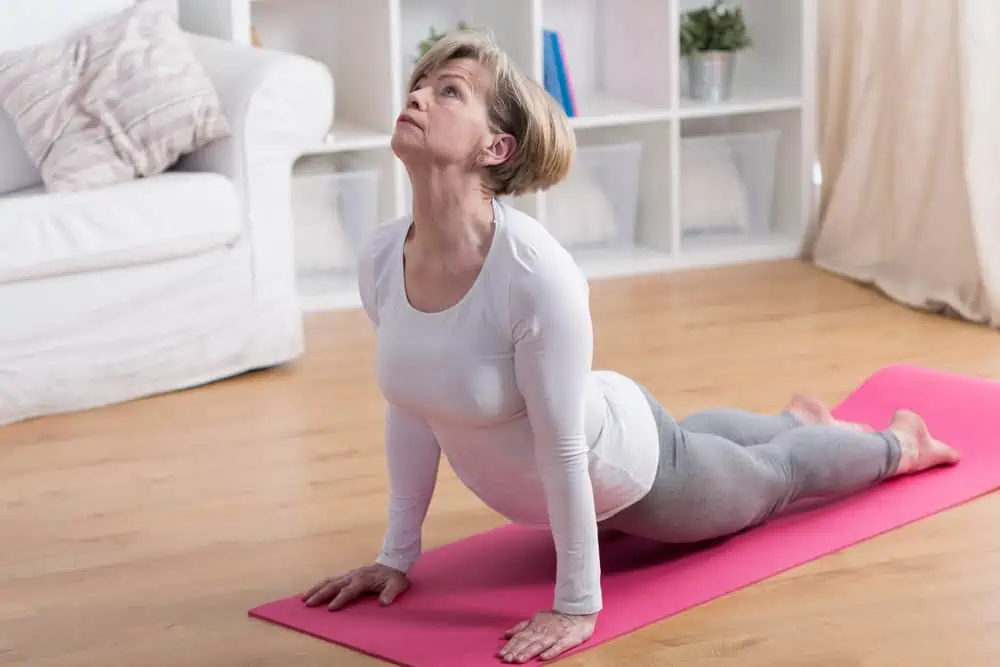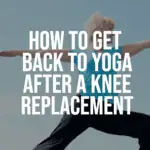This post may contain affiliate links. If you click through a link and make a purchase, I may receive a commission at no additional cost to you. As an Amazon Associate, I earn from qualifying purchases. Read the full disclosure here.
Knee pain can be a significant barrier to enjoying yoga. After a total knee replacement, it’s natural to wonder what physical activities will be comfortable and accessible.
Can you do yoga after a knee replacement? Absolutely.
However, you may need to adapt some poses to make them more comfortable for your new knee, especially within the first few months of returning to yoga.
Keep reading to learn how to navigate a yoga practice after a total knee arthroplasty.
- Benefits of yoga after a total joint replacement
- Things to consider before your surgery
- Timeline for healing after a total knee replacement
- Considerations when returning to a yoga practice
- More tips for returning to yoga after a joint replacement
- Yoga props to help make poses more accessible
- Best styles of yoga to try after a knee replacement
- Yoga poses to be cautious with after a knee replacement
Disclaimer: This content is for educational purposes and is not medical advice. Read the full disclaimer.
Benefits of yoga after a total joint replacement
After a total knee replacement, yoga can help improve strength and mobility, range of motion, flexibility, balance, and decrease pain and stress.
- Improve strength and mobility
- Improve range of motion
- Improve flexibility
- Improve balance
- Decrease pain and stress
Classes can also provide a social aspect, which is very important for some people as they heal.
Things to consider before your surgery
In today’s healthcare world, you need to be your own advocate and do your research. Planning to reach your goals even before your surgery is a smart decision.
Like not all yoga teachers are familiar with how to help a student after knee replacement surgery, not all surgeons and physical therapists are familiar with yoga.
Many view yoga as a gentle practice compared to general exercise. Therefore, little to no guidance may be provided. Depending on the style of yoga you like to practice, many nuances may be unknown to those who aren’t familiar, leaving you to navigate your way back on your own.
Before your surgery, you can search for a physical therapist who is either a yoga teacher or has experience in yoga and can help you with more specifics.
If you’re not able to work with a physical therapist who has yoga experience, the next best thing is to show pictures of poses you’d like to be able to do. Your therapist can better tailor your rehab to your personal goals if they can fully understand what movements you’d like to get back to.
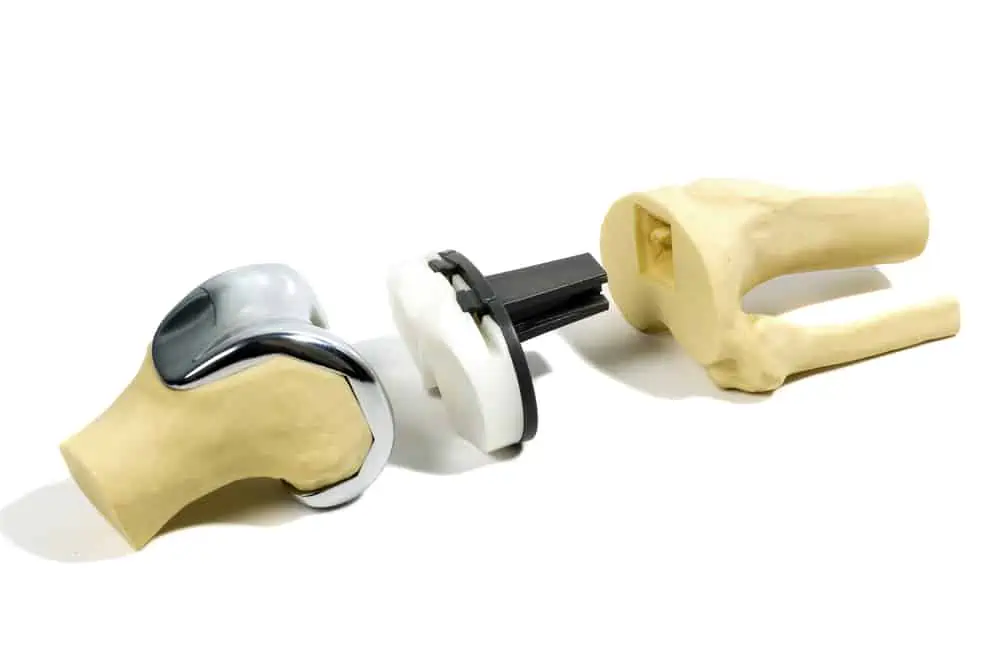
Timeline for healing after a total knee replacement
Joint replacement surgery is improving, and people can return to more activities than ever before.
That being said, a total knee replacement is still a fairly invasive surgery. To set expectations appropriately, it’s a good idea to look at tissue healing timetables to have a realistic idea of when you’ll be able to return to a yoga practice.
The rehab protocol follows similar patterns for straightforward, uncomplicated knee replacement surgeries. Most people return to comfortable everyday activities within three months after surgery.
Other more athletic activities may take 6+ months. It’s always best to discuss your activity goals with your doctor before surgery to establish the most realistic timeline.
There are many different sample protocols available online, however, your specific protocol will depend on your surgeon, your specific surgery, and any other pertinent medical issues.
I’ve had hundreds of patients in physical therapy after total knee replacement surgery. On average, the first 6-8 weeks are often the most difficult. Physical therapy sessions and home exercises are your full-time job during this phase.
Generally, the more effort you put in, the better you’ll do.
Initially, you’ll focus on regaining range of motion and mobility for basic activities like moving around your house and taking care of yourself.
Gradually, you’ll progress to strengthening, community mobility, and independence with daily tasks and transportation.
Ultimately, you’ll then progress to higher-level activities like returning to fitness and sports activities.
Your progression depends on your medical history, mobility before surgery, and other factors. But this doesn’t mean you can’t start taking small steps to support your return to yoga.
As lame as it sounds to someone looking to get back to a dynamic practice, if you can breathe, you can do yoga. There’s something in your practice that can meet you where you’re at. Starting with your breath is always available.
Considerations when returning to a yoga practice
Yoga is often viewed as a gentle practice; therefore, there can be little guidance other than the standing catch-all phrase “listen to your body.”
I’ve had many patients “cleared” for yoga after surgical procedures without any additional guidance.
Here are some key concepts to consider.
Do your doctor and physical therapist understand yoga?
This isn’t a knock to your doctor or PT, but if someone doesn’t practice yoga, they’re not familiar with the nuances of the practice. You can ask this before surgery as you search for the right healthcare practitioners for your team.
Some people’s only exposure to yoga is what they see on social media, either people twisted up in seemingly impossible positions or gentle stretching on a mat.
Be prepared with information about your yoga style and pictures of common poses to illustrate your movement goals. There are plenty of ways to modify poses at various increments to provide support and ultimately reach your goals.
Physical therapists are excellent at analyzing movement and breaking down small steps to reach your goals.
Getting up and down from the floor
Unless you’re returning to a chair yoga class, you’ll need to ensure you’re comfortable getting up and down from the floor safely.
No worries if this sounds intimidating. You can ask your physical therapist to practice this with you and show you techniques to make this transition as easy as possible.
If possible, a folding chair is a wonderful prop for the early phases (or any phase) and can make many poses or transitioning movements significantly easier.
Any sturdy folding chair will do, but this chair is designed specifically as a prop for yoga and has part of the back removed for easier access to poses, so it’s pretty cool.
If you practice at a studio, you can always ask if they have chairs available or the option for you to leave a chair at the studio for a period of time.
Kneeling
Difficulty kneeling is perhaps one of the largest barriers to returning to yoga after a total knee replacement.
Ask your surgeon when it’s ok to kneel on your new knee. Some doctors say six months, but it can be longer, depending on your surgeon’s preference.
Even when you get the all-clear to kneel, it may not be the most comfortable thing to do. Scar tissue on the front of the knee may be uncomfortable for quite some time. Discuss scar mobilization techniques with your physical therapist to improve soft tissue mobility and desensitize the area to reach your kneeling goals.
One of my favorite recommendations for kneeling is to use a balance pad. This cushion is approximately 3” thick and feels like kneeling on a cloud. It can also be a cushion to sit on or underneath your head when lying flat.
Even without surgery, kneeling on hard surfaces can be uncomfortable, so these pads are a great recommendation for everyone.

These cushions are often more comfortable than pads marketed specifically for kneeling and are a must-have for returning to yoga after a knee replacement.
Here are some of my other favorites to try:
A folded yoga blanket is also another option to add some padding underneath sensitive knees.
Remember, if you’re not comfortable kneeling, that’s completely ok. There are plenty of ways to modify your practice without causing discomfort. Kneeling isn’t a requirement if you don’t like it.
Limited range of motion
Regaining range of motion can be one of the most difficult things after knee surgery. While some may find they have more motion, many must work diligently to return to a certain level of motion.
Lacking knee flexion or end-range extension may limit your access to certain poses. Don’t worry; whatever you need, there’s a prop for that to make a pose more accessible.
Balance
After surgery, improvement happens quickly within the first few months. However, this doesn’t mean that improvement won’t continue. In fact, it may take one year or more to see what your yoga practice will look like after a knee replacement.
Don’t feel discouraged after a few months; things will continue to improve, especially if you continue to work on your strength and flexibility.
A simple folding chair can offer much-needed confidence as you regain strength and balance. You can use the back as a touch point for stability and sit or use the seat like a block for added support during many yoga poses.
More tips for returning to yoga after a joint replacement
Keep these things in mind as you navigate back to yoga and work with various teachers.
Make sure your yoga teacher knows you had a joint replacement
Even if you’re the type of person who likes to keep to themselves during practice, let your yoga instructor know up front that you had a knee replacement and if there’s anything you’re struggling with or are uncomfortable with.
They may be able to offer some additional options to you throughout the class. It’s also a good idea to protect yourself from unwanted hands-on adjustments or awkward moments in the middle of class.
In a perfect world, yoga teachers should ask for consent before placing their hands on a student, but this isn’t always the case. You never want to run into a situation where a teacher adjusts without asking, which causes you pain.
Don’t assume your yoga teacher is knowledgeable about your surgery
Yoga teachers may provide modification ideas to make poses more comfortable for you; however, yoga teachers are not healthcare providers (unless they are, which is a different conversation) and should never be providing rehabilitation or medical advice.
(If they are providing medical advice, that’s also a bit of a red flag.)
It’s up to you to understand your precautions and limitations after surgery
Always listen to your body and the advice of your surgeon and physical therapist. Don’t allow a yoga teacher to force you into a pose (also, don’t force yourself into any pose).
Pushing yourself too far too soon could compromise your rehab and set you back a few steps.
Avoid asking medical or rehab questions to your yoga teacher
As humans, we’re inherently curious and always looking for a free tip or trick to make our lives easier.
Society tends to view fitness and yoga professionals as somewhat of an authority on exercise and movement. While this may be true for some, it certainly isn’t true for all.
Unless your teacher also happens to be a medical professional (in which they also may not be able to offer medical advice while operating as a yoga teacher), these questions fall outside of their knowledge base and legal scope of work.
They should refer you to your healthcare providers for questions like these. However, that still doesn’t stop some people from sharing incorrect information or information based on personal experience – especially on social media.
Don’t take that the wrong way. It’s not a knock on yoga teachers, just a reality that every profession has a legal scope of work for a reason. It’s common in the yoga, wellness, and fitness spaces for some professions to overstep their bounds, which is a disservice to clients.
The moral of the story is to consult your healthcare team for medical questions and always consider where your information is coming from.
Yoga props to help make poses more accessible
Props will be a major advantage for you to comfortably participate in yoga while keeping yourself safe as you restore strength, function, and flexibility.
Don’t be discouraged about what you can’t do, go slow and utilize props to your advantage.
Related read: How To Use Yoga Blocks To Prevent Injury & The Best Non-Slip Yoga Mats For Sweaty Hands
Best styles of yoga to try after a knee replacement
Slower-paced classes offer additional time to get in and out of poses and comfortable placement of props.
Hatha, gentle yoga, and chair classes will help you ease back into your practice. Restorative practices may also be a helpful way to relax and reset during your recovery.
Yin yoga classes may or may not be comfortable just yet, it depends on which poses are focused on. In yin yoga, poses are held for an average of 2-5 minutes, which may be uncomfortable or not accessible within the first few months after surgery.
Check out my YouTube channel for some gentle yoga class options.
Yoga poses to be cautious with after a knee replacement
Be cautious with forcing your joint into an uncomfortable position. Poses that require full knee flexion, kneeling, or place torque through the joint will need to wait.
Be cautious with poses that place some torque through the knee joint, for example opting for reclined figure 4 instead of pigeon pose.
Using props to support the body during the this time will help make poses more adaptable as you improve.
So, can you do yoga after a knee replacement?
A total joint replacement comes with many questions. Make sure you have the right resources to return to physical activity.
Remember that it may take several months to return to full function, but that doesn’t mean you can’t take small steps along the way and incorporate yoga into your routine.
The best part about yoga is it’s ability to meet you where you’re at today.
Happy rehabbing!

